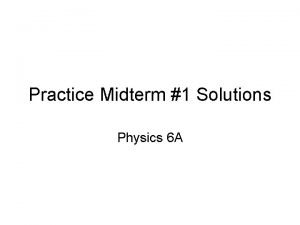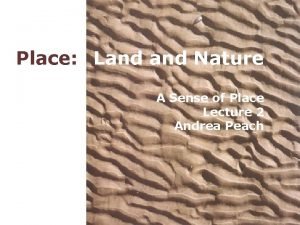Physics 7 E Prof D Casper Admin Midterm













- Slides: 13

Physics 7 E Prof. D. Casper

Admin • Midterm Friday, Chapters 12, 14, 15 • Formula sheet posted/distributed • Review session tonight, 6 – 8 pm, SSL 248 (format: Q&A) • Sign-up for left-handed seating on EEE by Thursday, 3 pm https: //eee. uci. edu/signupsheet/phys 7 elefty • No homework due tomorrow (Chapter 16 HW is due November 3, available on Mastering. Physics now) • Chapter 16 problems in discussion tomorrow

Standing Sound Waves Standing waves can occur in columns or tubes of air A closed end acts like the end of a fixed string (displacement node) An open end can have maximum displacement (displacement anti-node) Remember that pressure variation is shifted ¼ cycle from displacement Displacement node = pressure anti-node Displacement anti-node = pressure node

Similarities to Standing Waves on Strings Nodes and anti-nodes alternate Adjacent nodes: ½ wavelength apart Adjacent anti-nodes: ½ wavelength apart A column open at both ends has same fundamental frequency and harmonics as a string fixed at both ends

Differences from Standing Waves on Strings •

Q 16. 6 When you blow air into an open organ pipe, it produces a sound with a fundamental frequency of 440 Hz. If you close one end of this pipe, the new fundamental frequency of the sound that emerges from the pipe is A. 110 Hz. B. 220 Hz. C. 440 Hz. D. 880 Hz. E. 1760 Hz.

A 16. 6 When you blow air into an open organ pipe, it produces a sound with a fundamental frequency of 440 Hz. If you close one end of this pipe, the new fundamental frequency of the sound that emerges from the pipe is A. 110 Hz. B. 220 Hz. C. 440 Hz. D. 880 Hz. E. 1760 Hz.

Strategy for Standing Wave Problems •

Example: Open Column, 5 th Harmonic • Draw a picture with both ends open • Label ends (“A” for anti-node) • Ends are same, so add “N” for node in middle to make a valid pattern; this is first harmonic (fundamental mode) • For fifth harmonic, add 4 more nodes and 4 more anti-nodes • Find wavelength using spacing between adjacent anti-nodes Length L A N A N A N A

Example: Half-open Column, 5 th Harmonic • Draw a picture with one end open and one closed • Label ends (open: A, closed: N) • This is valid, so it is first harmonic (fundamental mode) • For half-open, only odd modes • 5 th harmonic is two modes above fundamental • Add two node/anti-node pairs • Find wavelength using spacing Length L A N A N

Interference and Sound Two crucial ideas: Superposition principle: when two different waves (for instance from different sources) overlap, the displacement is the sum or difference of the individual waves’ displacements Phase difference: two waves may be offset with respect to each other at the point of detection; the amount of offset determines whether they interfere constructively or destructively

Phase Differences Phase differences can be expressed in different, but equivalent ways: Expressed as… Constructive when… Destructive when… Wavelengths Periods Cycles Whole number (0, 1, 2, …) Radians Degrees General Terminology: In-phase (Constructive) vs. Out-of-phase (Destructive)

Interference in Two or Three Dimensions In two or three dimensions, geometry can lead to a more complex pattern of phase differences between two separated sources (Demo)

























